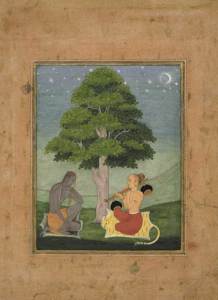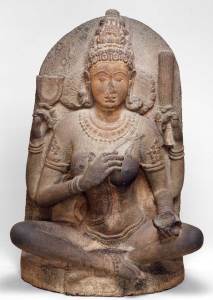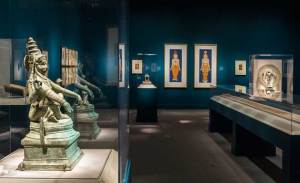It is generally presumed that those of us who study India seriously, whether western or Indian, start each day with an hour of tricky tree pose or downward dog with our rear end mid-air, and end it standing on our heads and twisting into a few contortions. In truth, this is rare. Even many millions of Indians do not practice yoga despite the god Krishna’s emphatic and repeated invocation in the brief Bhagvad Gita, a core piece of Hindu philosophy, that ‘Yoga is skill in action’.

Kedar Ragini India, Rajasthan, Bikaner (c. 1690–95), Ruknuddin. The Metropolitan Museum of Art, Gift of Mr and Mrs Peter Findlay
Perhaps this is why the study of how yoga influenced and inspired Indian art from early times is a relatively new sub-discipline for art historians of India’s vast, rich, diverse and long culture. ‘Yoga: the Art of Transformation’ is the first substantial show dedicated to the subject. Its meaty catalogue edited by Debra Diamond presents a very readable digest of some of the new and fascinating research, so that even if one knows a piece, here is a new take on it. And it comes at a moment when the practice of yoga has become a way for millions around the world to seek spiritual and physical balance in their stressed lives.
The gathering of masterpieces comes from the Sackler’s own fine collection and 25 other museums and private collections. Many items have not been seen in public before. There are life-sized statues, top quality miniature paintings, manuscripts, icons, intriguing photographs and even film – the show ends with a clip from Thomas Edison’s 1906 movie, Hindoo Fakir, the very first movie about India. In all, 130 exhibits zip the visitor through 2,000 years of yoga theory, practice and influence.

Yogini India, Tamil Nadu, Kanchipuram or Kaveripakkam (c. 900–975), Metagabbro. Arthur M. Sackler Gallery, Gift of Arthur M. Sackler
Four life-sized yogini statues, made in the 10th and 12th centuries, are especially powerful. India has produced monumental stone carving for two millennia thanks to its fine bedrock, its sophisticated ruler-patrons and its craftsmen. But these yoginis, female embodiments of yogic power, have something extra that puts the viewer on edge. They represent continuous and multiple transformations over time and across religious and geographical boundaries; they blur the distinction between goddess and mortal woman who can, with ritual, become divine; they can bestow ‘the fruits of yoga…. (the ability to) subjugate the three-fold universe’; but they are dangerous and must be pacified.

Gallery view, ‘Yoga: The Art of Transformation’, Arthur M. Sackler Gallery, Smithsonian. Photo: Neil Greentree
Moreover, they must be imagined in quantity: between 42 and 108 of these threatening women with their wild hair, weapons and abundant jewellery would be sat inside the circular wall of a temple open to the sky and dedicated to them. Medieval rulers, often keen devotees, built yogini temples in quantity but only a handful survive. The show is worth visiting for these alone.
‘Yoga: The Art of Transformation’ is at the Arthur M. Sackler Gallery, Washington D.C. until 26 January 2014.
Unlimited access from just $16 every 3 months
Subscribe to get unlimited and exclusive access to the top art stories, interviews and exhibition reviews.














![Masterpiece [Re]discovery 2022. Photo: Ben Fisher Photography, courtesy of Masterpiece London](http://www.apollo-magazine.com/wp-content/uploads/2022/07/MPL2022_4263.jpg)
It’s time for the government of London to return to its rightful home